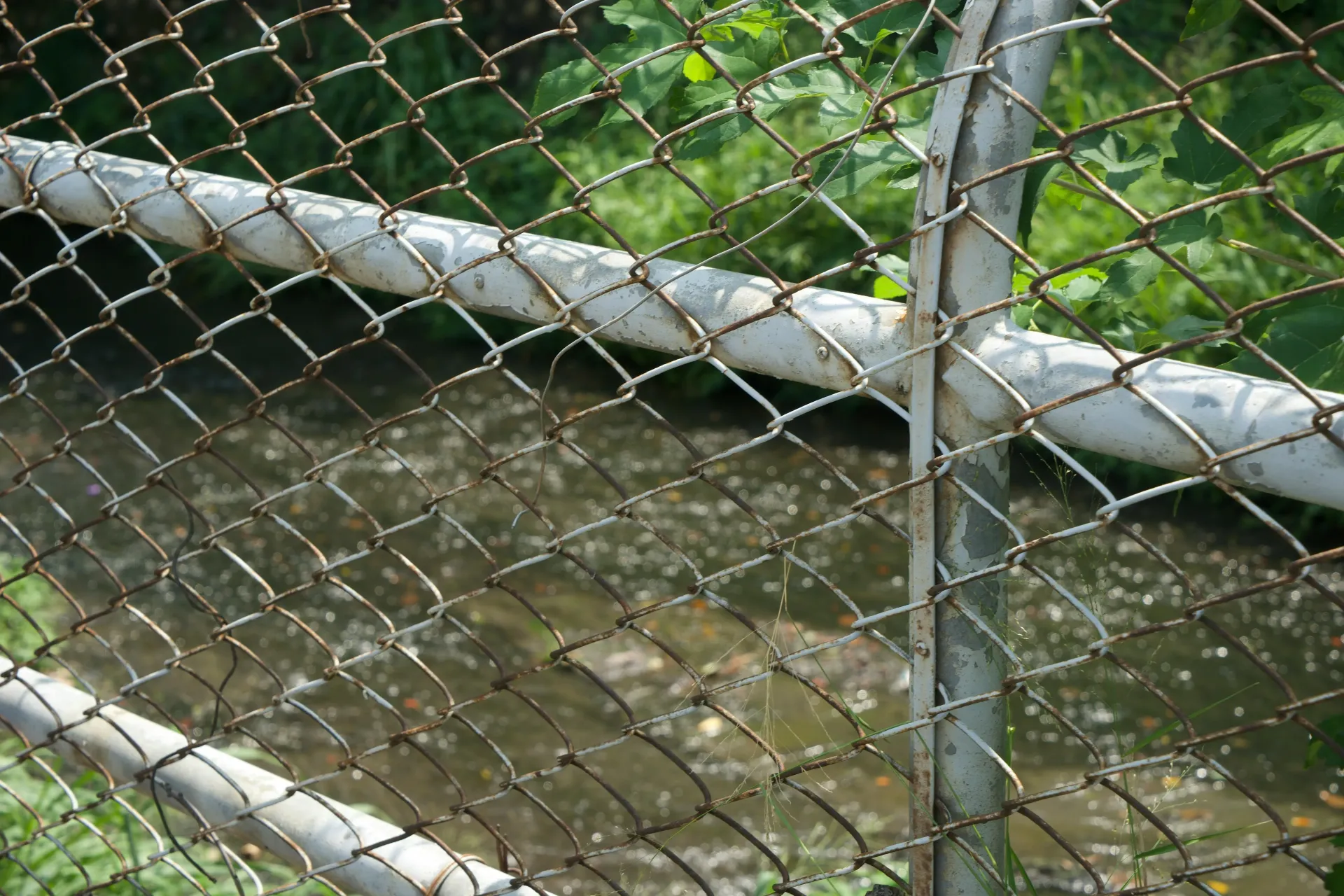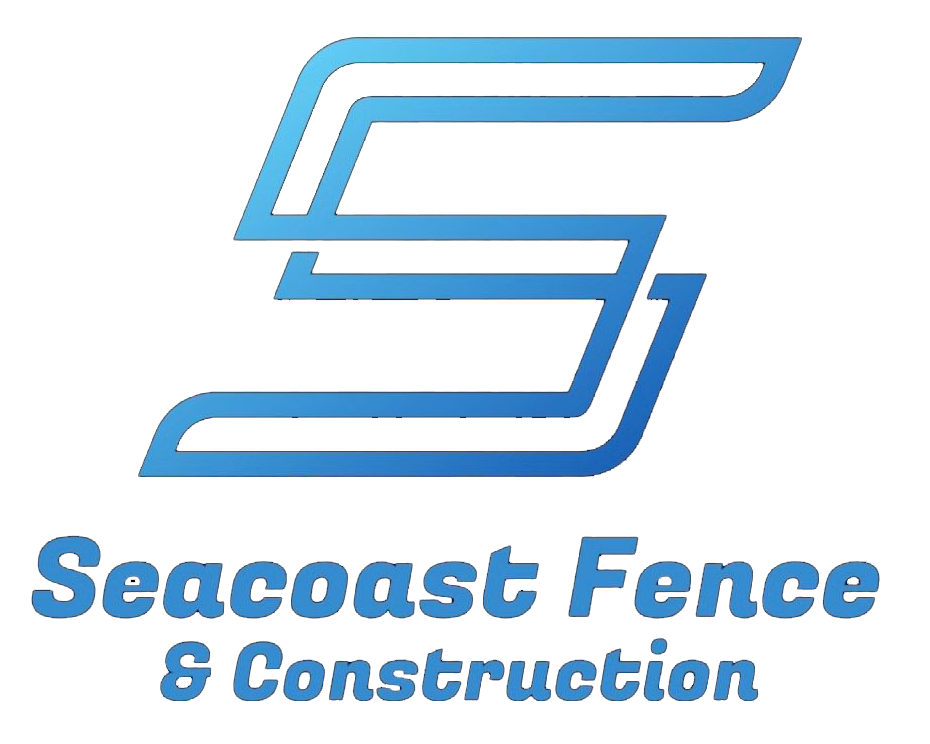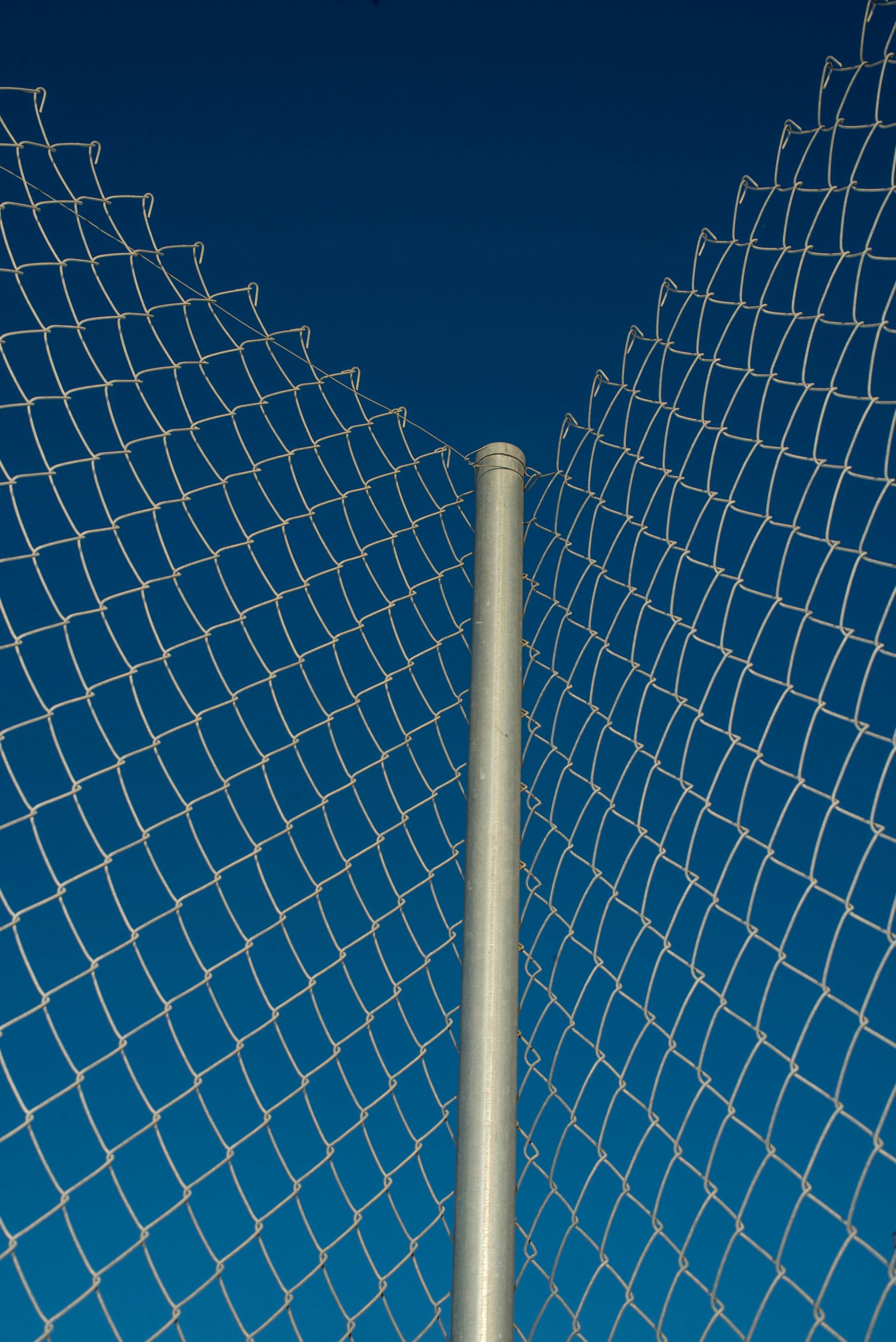Call Us: (207)-415-0219
How to Repair a Chain Link Fence and Fence Posts Easily?

DIY Solutions: Repairing a Chain Link Fence and Fence Posts Effortlessly
Wondering how to fix a bent chain link fence? Even though chain link fences are built to last, things like weather, accidents, or yardwork can damage the fence rail, bend a fence post, or break the chain link fabric. But don’t worry—most of these problems don’t need a full fence replacement. With the right tools, you can handle this fence repair yourself.
This DIY fence repair guide will show you how to repair a chain link fence, especially when you're dealing with a bent rail, damaged post, or a torn damaged section of mesh. You’ll learn how to cut out the bent part, add a replacement rail, and place a rail coupling to connect the rail on either side. We’ll also explain how to untwist the wire, reattach the fence fabric using wire ties, and install a new post if needed—complete with inches of gravel and how to pour the concrete for strong support.
Whether you're updating an existing fence or making repairs to keep your yard safe, these simple steps will help you straighten a damaged fence, tighten the structure, and extend the life of your chain-link fence. Grab your pliers, tension bar, and rail end brackets, and let’s get your fence looking strong again—without calling in a fence installation pro!
How to Begin Your Fence Repair Project?
Starting a fence repair project begins with a good assessment. Walk along the fence and inspect every section. Look for bent top rails, loose or broken posts, and any sections of chain link mesh that are damaged. Make a list of everything that needs fixing to ensure you don’t miss any spots.
Once you've made your assessment, gather the necessary tools and materials. Common tools include pliers, wire cutters, a wrench, and replacement parts like mesh, rails, or posts. It’s also helpful to wear gloves and safety glasses to protect yourself while working.
Finally, consider the weather. Since some repairs may require materials like cement, which need time to set, choose a dry day without rain or extreme temperatures. This way, your repair will hold up better in the long run.
What Tools Are Essential for Repairing a Chain Link Fence?
Having the right tools on hand makes all the difference when repairing a chain link fence. Here’s a list of essential items you’ll need:
Pliers: Useful for bending and twisting wire ties.
Wire Cutters: You’ll need these to cut through damaged sections of mesh or old wire ties.
Wrench: Handy for tightening bolts, especially if you're working on the top rails.
Replacement Wire Ties: These secure the chain link mesh to the fence posts and rails.
Replacement Rails or Posts: If the damage is too severe, you may need to replace the bent or broken parts.
Gloves and Safety Glasses: Always protect yourself from sharp edges and flying debris.
Having these tools ready before you begin ensures the job goes smoothly, and you won’t be caught off guard.
Preparing the Area: Ensuring a Smooth DIY Process
Before you start any actual repairs, it’s important to prepare the area around the damaged fence. Clear away any debris, overgrown grass, or plants near the fence. This will give you a better view of the damage and prevent any obstacles from slowing you down.
Next, if the fence is near your property line, make sure to check with neighbors if the repair work might affect their yard or property. It's always best to avoid misunderstandings.
Finally, make sure there’s enough room to work comfortably. Moving any items or obstacles near the fence, like lawn furniture or tools, can help prevent accidents or delays.
Safety First: What Precautions Should You Take?
Safety is key when working on a chain link fence repair. Here are a few precautions to ensure everything goes smoothly:
Wear protective gear: Gloves will protect your hands from sharp edges, while safety glasses keep debris out of your eyes.
Check for underground utilities: If you’re replacing a post, you might need to dig. Always make sure you won’t hit any pipes or wires by contacting your local utility company beforehand.
Secure your work area: If your fence repair is close to a sidewalk or street, make sure the area is clear of pedestrians and vehicles.
Lift heavy items properly: When lifting posts or heavy materials, bend at your knees and not your back to avoid injury.
Taking these steps will help prevent accidents and ensure a smooth repair process.
How to Repair a Bent Top Rail on a Chain Link Fence?
If you notice that the top rail of your chain link fence is bent, it’s important to repair it to maintain the fence’s stability and appearance. Fixing a bent rail is usually straightforward and can be done with a few simple tools.
Steps to Straighten a Bent Rail
- Loosen the rail ends: Use your wrench to loosen the nuts or bolts securing the bent rail to the fence posts. This will free the rail for easier handling.
- Remove the bent section: Slide the bent rail out of the fence framework. Be careful not to damage the mesh or other parts of the fence.
- Straighten the rail: Lay the bent rail on a flat surface. Use a pipe bender or a mallet to carefully straighten the rail. If the bend is too severe, consider replacing the rail.
- Reinstall the rail: Once straightened, slide the rail back into place. Secure it to the fence posts by tightening the nuts or bolts.
A straight rail helps keep the fence strong and prevents further issues.
When to Consider Replacing Instead of Repairing?
In some cases, repairing a bent rail isn’t enough. Here’s when you should consider replacing it:
Severe bends: If the rail has multiple bends or deep kinks that can’t be fully straightened, it’s better to replace it to avoid weakening the fence.
Rust or corrosion: If the rail shows signs of rust or corrosion, it may be compromised structurally. A new rail will ensure long-term durability.
Repeated damage: If the rail has been repaired multiple times and keeps bending, it’s probably time for a replacement to prevent future issues.
Replacing a severely damaged rail ensures your fence remains sturdy and reliable.
Tools Needed: Pole, Wrench, and More
To repair or replace a bent top rail on your chain link fence, you’ll need a few essential tools:
Pole: This helps you support and maneuver the rail, especially during installation.
Wrench: You’ll use this to loosen and tighten the bolts securing the rail to the posts.
Pipe Bender or Mallet: These tools are handy for straightening the bent rail if you choose to repair it.
Replacement Rail: If the existing rail is too damaged to repair, have a new one ready for installation.
Wire Cutters and Pliers: Useful for adjusting or cutting wire ties that may connect the mesh to the rail.
Having these tools ensures you can handle either repairing or replacing the top rail efficiently.
What to Do with a Damaged Fence Post?
A damaged or leaning fence post can cause the entire fence structure to weaken. Whether it’s rusted at the base, cracked, or bent, knowing how to handle a damaged post is crucial for maintaining your fence’s strength and durability. Repairing or replacing it can keep the fence upright and secure.
How to Remove and Replace a Damaged Post?
- Loosen the post: Start by loosening any concrete or dirt around the base of the damaged post. You can use a shovel or post-hole digger to clear away the surrounding material.
- Pull out the post: Once the base is loosened, carefully pull the damaged post out of the ground. If it's stuck, you might need a post puller or leverage using a sturdy bar.
- Prepare the hole: After removing the post, clear out any remaining debris from the hole. Make sure the hole is deep enough (usually about 2 feet or more) to properly secure the new post.
- Insert the new post: Place the new post in the hole, ensuring it's level and aligned with the rest of the fence.
- Secure the post: Use concrete or gravel to set the new post in place. Fill the hole around the post with the chosen material and tamp it down firmly.
Replacing a damaged post ensures the fence remains upright and stable.
Setting the New Post: Cement and Gravel Techniques
There are two popular methods to set a new post securely: using cement or gravel.
Cement Method
- Mix the concrete: Follow the instructions on the bag to mix the concrete. You’ll usually need to add water and stir until it reaches a thick consistency.
- Pour the concrete: Pour the mixed concrete into the hole around the post, making sure the post stays level.
- Let it set: Allow the concrete to dry for at least 24 to 48 hours before applying any tension to the post.
Gravel Method
- Fill the hole with gravel: Instead of concrete, fill the hole with gravel, packing it down tightly around the post.
- Check for stability: Make sure the post is level and firmly in place. This method is quicker than using concrete but may not be as stable in the long run.
Both methods work, but concrete provides extra durability, especially for larger fences or high-stress areas.
How to Fix a Damaged Section of Chain Link Mesh?
When a section of chain link mesh is damaged, it can make your fence look worn and compromise its strength. Fortunately, repairing or replacing a section of mesh is straightforward. Whether the damage is due to wear and tear or an accident, restoring the mesh will keep your fence secure and looking good.
How to Cut and Weave a New Section of Mesh?
- Measure the damaged section: Start by measuring the size of the damaged area. This will help you cut a new section of mesh that fits perfectly.
- Cut the new mesh: Using wire cutters, cut a replacement section of chain link mesh that matches the size of the damaged area. Make sure to leave a little extra for weaving it into the existing fence.
- Weave the new section into place: To attach the new mesh, weave the loose ends of the replacement section into the old mesh. This helps create a seamless connection between the old and new sections. Use pliers to twist the wire and secure the weave tightly.
This process allows you to repair the damaged area without needing to replace the entire fence.
Attaching the New Section: Wire Ties and Fasteners
- Secure the mesh to the fence posts: Once the new section of mesh is woven in, use wire ties to attach it to the fence posts. Space the ties evenly, usually about 12 inches apart, for even support.
- Tighten the mesh: Pull the mesh tight to ensure there’s no sagging. This will keep the fence sturdy and maintain its appearance.
- Use fasteners for extra security: In areas that need extra support, especially near gates or corners, use additional fasteners to reinforce the attachment points.
This method ensures that the new mesh stays firmly in place and blends smoothly with the rest of the fence.
Ensuring the Mesh is Secure and Aligned Properly
- Check alignment: Once the new section of mesh is attached, step back and check that it aligns evenly with the rest of the fence. The mesh should sit straight along the top and bottom rails without any noticeable dips or waves.
- Tighten wire ties if needed: If there’s any slack, tighten the wire ties or add more to secure the mesh better.
- Final adjustments: Make any final adjustments by gently pulling the mesh tighter or repositioning it to ensure a clean, secure fit.
With the mesh properly aligned and secured, your fence will look good as new and remain durable for years to come.
Should You Hire a Professional or Go DIY?
Deciding whether to handle a chain link fence repair yourself or hire a professional depends on the complexity of the damage and your comfort level with the tools. While many fence repairs can be done as a DIY project, there are times when bringing in a pro might be the better option.
Pros and Cons of DIY Fence Repairs
Pros
- Cost savings: Doing the repairs yourself can save you money on labor costs.
- Flexibility: You can work on the project at your own pace without having to schedule around a contractor.
- Satisfaction: There’s a sense of accomplishment that comes from completing a repair on your own.
Cons
- Time-consuming: Depending on the repair, it might take longer than expected, especially if you're unfamiliar with the process.
- Skill level: Some repairs may require specialized tools or skills you might not have, leading to potential mistakes.
- Safety risks: Certain repairs, like replacing posts or dealing with sharp wire, can be hazardous without proper precautions.
Weighing these pros and cons can help you decide if DIY is the right choice for your fence repair.
When It's Probably Best to Call a Professional
Sometimes, hiring a professional is the better route. Here’s when you should consider it:
- Extensive damage: If large sections of the fence are damaged, or multiple posts need replacement, it might be beyond a simple DIY fix.
- Structural issues: If the damage affects the overall stability of the fence, such as leaning posts or sagging sections, professional expertise may be required.
- Time constraints: If you need the fence repaired quickly and don’t have the time to invest in a DIY project, a professional can get it done efficiently.
- Special tools: Some repairs might require tools or equipment that you don’t have, making it more practical to call in a pro.
Hiring a professional can save you time and ensure that the job is done correctly, especially for more complicated repairs.
Conclusion
Repairing a chain link fence doesn’t have to be complicated. Whether you’re dealing with a bent rail, damaged post, or torn mesh, following these simple steps will help you restore your fence quickly and efficiently. With the right tools and techniques, you can save money by taking on these repairs yourself. However, if the damage is extensive or you’re pressed for time, hiring a professional is often the best way to ensure the job is done right.
If you're looking for expert help with your fence, consider Seacoast Fence and Construction in Biddeford, ME. Their team offers top-notch fence installation and repair services for both residential and commercial properties. Whether it's chain link, wood, vinyl, or aluminum, Seacoast Fence and Construction has the skills and experience to handle any project. Trust them to deliver durable, beautiful results that enhance the security and aesthetics of your property.
Contact Seacoast Fence and Construction today to schedule your consultation and get your fence back in shape!
FAQs
How do I begin chain link fence repairs effectively?
Begin by assessing the damage to the existing fence. Determine if you'll need to repair the chain link fabric or replace fence posts. Ensure you have all necessary tools such as a pair of pliers, a metal blade, and a reciprocating saw.
What tools are essential for repairing a chain link fence?
Essential tools include linesman’s pliers, a reciprocating saw with a metal blade, a hacksaw, and a pair of pliers. You may also need a pipe for leverage, a rail coupling to connect pieces, and concrete mix for securing posts.
How can I handle a bent chain link fence post?
To tackle a bent chain link fence post, first loosen the post caps and brackets. Then, use a hacksaw or reciprocating saw to cut out the bent portion of the fence. Install a new post if necessary and fill the hole with a concrete mix for stability.
How do I replace damaged chain link fabric?
Start by removing the damaged portion of the fence fabric by untwisting it from the existing rail. Cut the existing fabric with pliers if needed. Then, attach a new piece of chain link fabric loosely and tighten it by reattaching it to the rails.
What steps should I follow to repair a sagging fence?
To repair a sagging fence, tighten the top and bottom rails using a coupling. Adjust the tension of the chain link fabric and reattach it to the posts to ensure it is stretched evenly.
When should I consider replacing instead of repairing?
Consider replacing parts of the fence when rust or severe damage affects the structural integrity. If the chain link fence post is corroded or the fence fabric is extensively torn, it may be better to install a new section.
How do I maintain my fence to avoid frequent repairs?
Regularly inspect the fence for rust and damage. Galvanize exposed metal parts to prevent rust and ensure the concrete base is intact. Tighten loose components and consider applying a protective coating to prolong the life of the fence.
What is the process of taking care of the bottom of the fence?
Ensure the bottom of the fence is free from debris and vegetation that can cause rust. Regularly check that the fence fabric is secure and the ground is not eroding around the posts.
Is DIY fence repair recommended for homeowners?
DIY repairs can be effective for minor issues such as tightening a loose rail or replacing a small segment of chain link fabric. However, for extensive chain link fence repairs, it might be wise to consult with a professional to ensure proper fence installation and longevity.
Our Services
Contact Information
Phone:
Address:
642 Elm St Unit 3, Biddeford ME 4005
Business Hours
- Mon - Fri
- -
- Sat - Sun
- Closed
Tips & Articles


